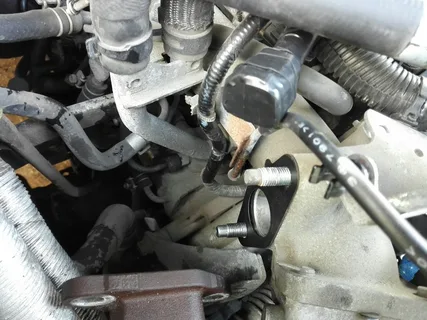The Nissan Navara D40 EGR Valve plays a crucial role in emissions control for the Nissan Pathfinder R51. This component recirculates some exhaust gases back into the engine intake to reduce harmful emissions. Understanding the EGR valve’s importance and impact on engine performance is essential for maintaining optimal vehicle efficiency.
Introduction to the EGR Valve
The Exhaust Gas Recirculation (EGR) valve is an integral component in the emissions control system of modern vehicles, including the Nissan Pathfinder R51. Its primary function is to mitigate nitrogen oxide emissions, a common byproduct of engine combustion processes. The valve effectively reduces the combustion temperature by recirculating a controlled amount of exhaust gases back into the combustion chambers.
This reduction in temperature is crucial, as it directly impacts the amount of nitrogen oxides produced during the combustion cycle. Understanding the operational mechanics and benefits of the EGR valve is fundamental for vehicle owners aiming to maintain their vehicle’s efficiency and environmental compliance.
EGR Valve Functionality
The operation of the EGR valve is pivotal in moderating the engine’s combustion temperature to curb the creation of nitrogen oxides, notorious for their environmental impact. This valve judiciously manages the re-entry of exhaust gases into the combustion chamber, ensuring that only the necessary amount is reintroduced to achieve optimal temperature reduction without compromising engine performance.
The dynamic opening and closing of the valve are crucial in maintaining the delicate balance between reducing harmful emissions and preserving the engine’s efficiency. Through its sophisticated control mechanism, the EGR valve significantly contributes to the vehicle’s adherence to emissions standards whilst also playing a part in enhancing fuel efficiency by improving combustion. This dual role underscores its importance in the engine’s ecosystem, making its functionality central to the vehicle’s operation and environmental footprint.
Importance of Emissions Control
Emissions control stands at the forefront of modern automotive design, underpinning efforts to minimise the ecological footprint of vehicles on the environment. It’s pivotal in safeguarding air quality by limiting the output of harmful pollutants known to exacerbate climate change and harm public health. For vehicle owners, adhering to emissions regulations is about legal compliance and contributing to a broader initiative to curb environmental degradation.
By mitigating the release of nitrogen oxides, the EGR valve plays a key role in this process, demonstrating how integrated vehicle technologies are in the pursuit of cleaner air. Through effective emissions control, we ensure a legacy of sustainability for future generations, marking a commitment to ecological stewardship and responsible vehicle ownership.
Design and Components of the EGR Valve
The Exhaust Gas Recirculation (EGR) valve is a crucial component in modern internal combustion engines. It plays a significant role in reducing nitrogen oxide (NOx) emissions by recirculating a portion of the engine’s exhaust gases back into the intake manifold. This process helps lower combustion temperatures, thereby minimizing the formation of NOx gases. Let’s explore the design and key components of the EGR valve.
Function and Maintenance
The EGR valve helps maintain optimal engine performance and emissions levels. Regular maintenance, including cleaning or replacing the EGR valve, is essential to ensure it operates correctly and prevents issues like carbon buildup or clogging. Proper functioning of the EGR valve contributes to better fuel efficiency and compliance with emission standards.
EGR Valve in the Nissan Navara D40
The Nissan Navara D40, renowned for its robustness and reliability, incorporates the EGR valve as a pivotal component in its emissions reduction strategy. Ensuring this valve operates efficiently is vital, as it directly influences the vehicle’s environmental footprint and engine performance. Owners should prioritise the upkeep of this valve through regular checks and cleaning, particularly given the vehicle’s propensity for demanding driving conditions.
Such attention mitigates common EGR valve issues, such as carbon accumulation and ensures the longevity and efficacy of the system. This proactive maintenance supports the Navara D40 in meeting emissions standards and maintains its performance credentials.
Common Issues with EGR Valves
EGR valves are susceptible to several operational challenges that can impact vehicle performance. A frequent issue is the accumulation of carbon deposits, which can obstruct the smooth flow of exhaust gases, leading to inefficiencies. Additionally, the valve itself may become stuck, either in an open or closed position, disrupting the engine’s air-fuel mixture and affecting combustion.
Solenoid failure represents another common problem: the electronic component that controls the valve’s operation malfunctions, hindering the precise regulation of gas recirculation. Regular inspection and diligent maintenance can help identify these issues early, preventing more significant engine concerns and ensuring the continued efficient operation of the EGR system.
Impact on Engine Performance
When an EGR valve functions suboptimally, it can lead to noticeable declines in the vehicle’s performance. Issues such as stuttering acceleration, a marked decrease in power, and an inconsistent idle may become apparent. These symptoms indicate the engine is not operating within its optimal parameters, primarily due to an improper air-to-fuel ratio caused by incorrect exhaust gas recirculation.
Fuel efficiency can also deteriorate as the engine compensates for these imbalances by consuming more fuel. Addressing EGR valve concerns promptly ensures engine performance is not adversely affected, allowing for smoother operation and sustained fuel economy.
Maintenance Tips for the EGR Valve
The Exhaust Gas Recirculation (EGR) valve plays a critical role in reducing emissions and improving engine efficiency. Regular maintenance of the EGR valve can prevent costly repairs and keep your vehicle running smoothly. Here are some essential tips to keep your EGR valve in top condition:
Regular Inspection
Check your EGR valve periodically for signs of carbon buildup, which can affect its performance. Look for any signs of leakage or damage that could compromise its function. Regular inspections help you catch potential issues early before they escalate.
Clean the EGR Valve
Carbon deposits can clog the EGR valve over time, leading to reduced engine performance and increased emissions. Cleaning the valve involves removing it from the engine and using a suitable cleaner to remove the carbon buildup. Ensure you follow the manufacturer’s guidelines for cleaning to avoid damaging the valve.
Check for Proper Functionality
Ensure the EGR valve is operating correctly by testing it for responsiveness. If your vehicle’s engine is idling roughly or the Check Engine light is on, it could be an indication that the EGR valve isn’t functioning properly. Consult your vehicle’s manual for specific testing procedures.
Key Components
Valve Body
The valve body is the main part of the EGR valve. It houses the internal components and is typically made from durable metals like aluminum or stainless steel. The body includes passages through which exhaust gases flow back into the engine.
Diaphragm
The diaphragm is a flexible membrane within the EGR valve that moves in response to engine vacuum changes. It controls the flow of exhaust gases by opening or closing the valve.
EGR Valve Position Sensor
This sensor monitors the position of the EGR valve and provides feedback to the engine control unit (ECU). Accurate positioning is crucial for proper EGR function and emission control.
Vacuum Control Mechanism
In many EGR systems, a vacuum control mechanism, such as a solenoid or actuator, regulates the diaphragm’s movement. This mechanism ensures that the EGR valve opens and closes at the appropriate times based on engine conditions.
Replace Faulty EGR Valves
If cleaning does not resolve performance issues or if the valve is physically damaged, replacing it may be necessary. Using high-quality replacement parts ensures compatibility and longevity, maintaining optimal engine performance.
Monitor Engine Performance
Keep an eye on your engine’s performance and fuel efficiency. Poor performance or increased fuel consumption could indicate problems with the EGR system. Regular maintenance and prompt attention to issues will help keep your engine running smoothly.
By following these maintenance tips, you can extend the life of your EGR valve and ensure your vehicle operates efficiently.
Replacing the EGR Nissan Pathfinder R51
When replacing the EGR Nissan Pathfinder R51 valve due to wear or malfunction, selecting the correct component is crucial for maintaining your vehicle’s performance and compliance with emissions regulations. Begin by identifying a compatible replacement, considering whether an OEM (Original Equipment Manufacturer) or a high-quality aftermarket part best suits your needs and budget. Installation of the new EGR valve should be conducted by a professional or under expert guidance, as precise placement and connection are essential to ensure the system functions correctly.
It’s also advisable to check the entire EGR system during the replacement process for any additional issues that could compromise the new valve’s operation, such as blockages or leaks in the connecting hoses. Implementing these steps diligently will help secure the continued efficiency and environmental performance of your Nissan Pathfinder R51.
Cost Implications
Addressing the implications of EGR valve maintenance or replacement cost is imperative for Nissan Pathfinder R51 owners. The expense can vary widely, depending on whether you opt for an OEM part or an aftermarket alternative. Labour costs also play a significant role, as the complexity of replacing the EGR valve can lead to varied charges by professionals. Proactive maintenance might entail smaller, more frequent expenditures but can ultimately forestall the need for a costlier total replacement.
Vehicle owners should weigh these considerations carefully, considering the long-term benefits of maintaining engine efficiency and emissions control against the immediate financial outlay. It’s advisable to consult with a trusted mechanic to understand the specifics of your situation, ensuring you make a cost-effective decision that aligns with your vehicle’s requirements.
Aftermarket vs OEM EGR Valves
Choosing between aftermarket and OEM EGR valves for your Nissan Pathfinder R51 necessitates carefully evaluating quality and cost implications. Aftermarket parts often present a more cost-effective solution, potentially offering significant savings. However, they may vary in terms of compatibility and durability. On the other hand, OEM parts are manufactured to the vehicle manufacturer’s exact specifications, ensuring a perfect fit and reliable performance.
While typically more expensive, they provide peace of mind through guaranteed compatibility and possibly longer lifespan. Vehicle owners should consider their priorities, whether the assurance of an exact match and longevity with OEM parts or the attractive pricing of aftermarket alternatives. Balancing these considerations is key to making an informed decision that suits both your vehicle’s needs and your budget.
Conclusion and Final Thoughts
In summary, the significance of Nissan Navara D40 EGR Valve within the emissions system cannot be overstated. Its role in minimising environmental impact, alongside maintaining the vehicle’s performance, highlights its necessity. Adherence to a diligent maintenance routine, coupled with timely intervention when faults arise, underpins the long-term health of the engine and the environment. It’s pivotal for owners to grasp the balance between operational efficiency and emissions control, ensuring their Pathfinder R51 remains a testament to sustainable motoring. Through conscientious care and informed decision-making regarding replacements, the vehicle’s contribution towards a cleaner atmosphere is optimised, embodying responsible ownership in the process.
FAQs
What is the primary function of the EGR Nissan Pathfinder R51?
The EGR Nissan Pathfinder R51 (Exhaust Gas Recirculation) valve plays a crucial role in controlling emissions. Its main function is to recirculate some exhaust gases back into the engine’s combustion chambers. This process helps reduce the combustion temperature, which lowers the production of nitrogen oxides (NOx), a harmful pollutant. By managing the exhaust gas flow, the EGR valve ensures compliance with emissions standards and contributes to a cleaner environment.
What are common issues with the EGR valve, and how can they affect performance?
Common issues with the EGR valve include carbon build-up, which can block the flow of exhaust gases and mechanical faults like the valve sticking open or closed. These problems can lead to decreased engine performance, such as poor acceleration, reduced power, and erratic idling. Additionally, a malfunctioning EGR valve can impact fuel efficiency and overall vehicle performance, necessitating timely maintenance or replacement.
How often should the EGR valve be inspected and maintained?
Regular inspection and maintenance are essential for optimal performance. As specified in your vehicle’s service manual, it’s generally recommended to check the EGR valve every 30,000 to 50,000 miles. During inspections, look for signs of carbon deposits or wear and clean or replace the valve as needed. Adhering to a regular maintenance schedule helps prevent issues and ensures the valve operates efficiently.
What are the cost implications of replacing an EGR valve in the Pathfinder R51?
The cost of replacing an EGR valve in the Nissan Pathfinder R51 varies depending on whether you choose an OEM or aftermarket part. OEM valves typically cost more but offer guaranteed compatibility and reliability. Aftermarket parts may be less expensive but vary in quality. Labour costs for installation can also vary based on your location and mechanic. Regular maintenance can mitigate the need for costly replacements, making it essential to address minor issues early.
Should I choose an OEM or aftermarket EGR valve for my Nissan Pathfinder R51?
Choosing between OEM and aftermarket EGR valves depends on your priorities. OEM valves are designed to meet the exact specifications of your vehicle, ensuring a precise fit and reliable performance, but typically come at a higher cost. Aftermarket valves can be more affordable and may offer savings, but quality and compatibility can vary. Consider your budget and the importance of guaranteed performance when making your decision. Consulting with a trusted mechanic can also guide you on the best vehicle choice.



